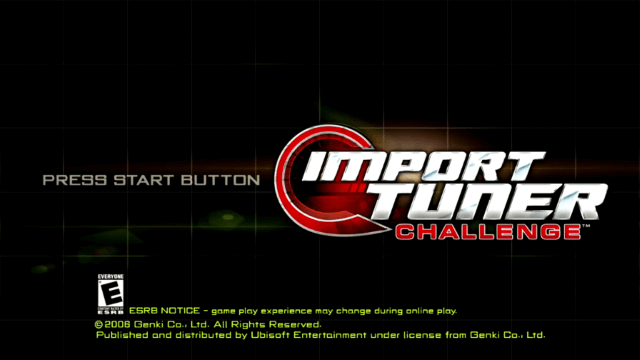With the Xbox 360’s 20th anniversary barreling towards at an unstoppable pace, I thought it’d be fun to get ahead of the inevitable nostalgia wave and look at one of the interesting smaller releases from the early 360 era: Genki’s Import Tuner Challenge.
One of the things I miss most from the 360’s life (or at least from the early part of the console’s life) is the proliferation of mid-tier developers; developers who were too small to match the budgets of the emerging AAA titans, but had access to the kinds of resources not available to the tiny indie teams/solo developers who would flourish (in the popular eye at least) slightly later. Though often not as complete or as polished as more major titles, their games were often based around one or two innovative ideas that were either completely new ideas that pushed gaming forward or hyper-focused takes that took an existing idea and twisted it in an interesting new direction.
Unfortunately, these mid tier games weren’t necessarily treated with complete respect. This was especially true when it came to localisation: aside from eternal problem of publishers running less important titles through lower-quality translation routes, games were often renamed or altered for Western releases when different publishers picked up different entries in a series. This could turn a collection of games that were a single homogeneous story/idea in Japan into a group of disparate one-offs the US/UK.
Case in point, If you saw it on a shelf in 2006 then your eyes would probably glaze over the box for Import Tuner Challenge. Featuring a generic-sounding title matching a generic-looking cover that focused on a generic-looking modified Toyota, Import Tuner Challenge would have just looked like another cheap street racing game that was desperately hiding behind a license to try and cash in on the Fast and Furious phenomenon.
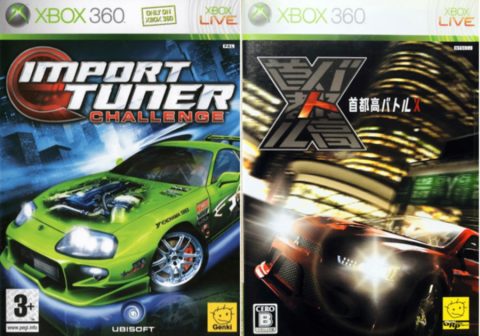
What the licensed title would be hiding,however, was that this game was in a direct sequel to one of the best and most original racing series on the Sega Dreamcast and Sony PlayStation 2. You see, in Japan the Game wasn’t Import Tuner Challenge at all, but Shutokou Battle X – the latest entry in the series known as Tokyo Xtreme Racer in America and (for some reason) Tokyo Highway Challenge in Europe.
The Shutokou Battle series was the brain child of Genki, an off-beat game developer started by ex-Sega employees Hiroshi Hamagaki and Tomo Kimura. In 1994, the company released the original Shutokou Battle on the SNES: Shutokou Battle ’94. The game was a mode 7 circuit racer that graphically left a lot to the imagination, but had gameplay that captured the thrill of drifting round tight city-based circuits.
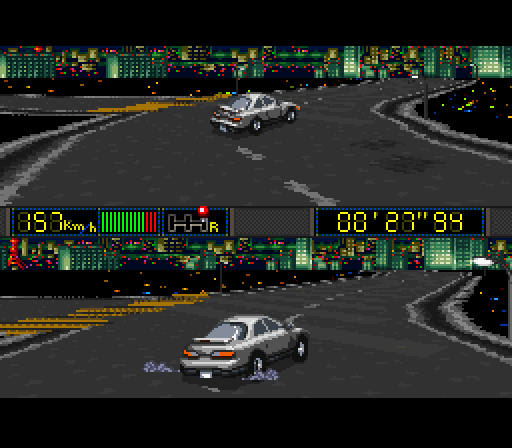
With the first generation of 3D consoles arriving just after ’94’s release, the team continued to hone their craft. The following year, they released Wangan Deadheat (Highway 2000 on the Saturn), another metropolitan circuit racer that made use of the Saturn’s impressive abilities to build 3D city-scapes to race in and to have FMV-based female co-drivers who would critique the player’s driving abilities. An upgraded ‘real arrange’ version of Deadheat followed soon after, before Genki released their crowning glories of their Saturn/Playstation era: Shutokō Battle R for the PlayStation and Shutokou Battle ’97 – localised as Tokyo Highway Battle – for the Saturn and PlayStation. These were still arcadey circuit racers but they definitely stood out from the crowd with their realistic Tokyo and (in the case of R, Osakan) track settings.
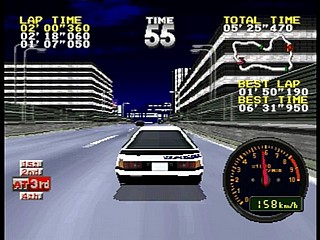
With Genki having access to Sega’s more powerful Dreamcast hardware the following year, the new iteration (*sigh* Shutokou Battle in Japan, Tokyo Xtreme Racer in the US and Tokyo Highway Challenge in Europe) stuck with the realistic highway setting but changed the mechanics entirely. What they came up with was somewhat revolutionary: Rather than individual tracks, the game featured one large open world location: Tokyo’s Inner Circular Route (C1) ring road. Rather than have structured races accessed via a menu, races were triggered as part of the gameplay: encounter another suped-up racing machine out in the wild and a quick flash of the headlights is enough to trigger a race.
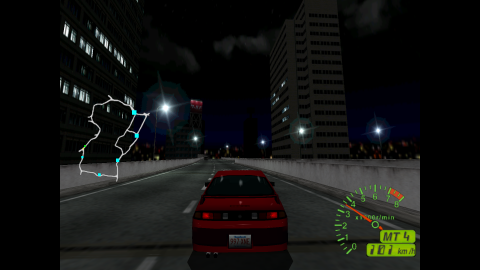
Not that the races themselves are normal either. In fact, races in the series are framed more like fighting game battles: with no specific goal to reach, the race is entirely based around energy bars that appear at the top of he screen. Pulling away from the drains their spirit energy, crashing or letting them pull away from you drains yours. The winner is the first one to empty their opponents energy bar. With the battle over credits are awarded to the victor the player is free to continue cruising the ring, hunting for their next opponent.
As an attempt to turn a racing game into an action-RPG , Shotokou Battle/Tokyo Xtreme Racer/Tokyo Highway Challenge was a fascinating concept that worked surprisingly well. With a huge amount of unlicensed (but still instantly recognisable) cars to upgrade and personalise and a large number of enemy racing teams to take down (complete with unlockable biographic details of any racers you defeat) your endless street battles have a clear sense of context and progression.Though there were some issues with the handling, the relative small nature of the map, and the general repetitiveness of the game loop,these were fixed in sequels/prequels which offered better handling, better graphics,more areas of Tokyo and – in a title that never made it to the West – the return of Osaka to the series too!
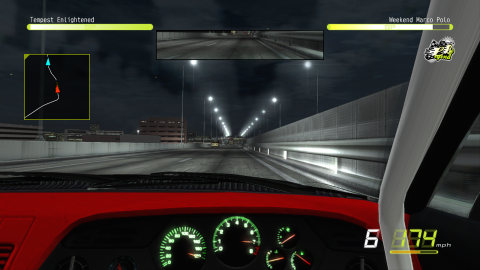
Enter, then, Shotokou Battle X/Import Tuner Challenge. The title marked a departure for the series in a number of ways. The first is that it was an earlyish title for Microsoft’s fancy new 360 console. Gaming had entered an exciting new ‘HD’ era and the game had to look good in resolutions that were far higher than anything the PS2 or the Dreamcast could muster. This meant the assets created for the older PS2 titles simply weren’t going to cut the mustard. On top of that the series had – for the first time – moved into the arena of licensed cars, removing the huge roster of copycats with a smaller number of vehicles that were supposed to be the real deal. These two factors came together to make import tuner challenge a smaller experience than it’s immediate forebears: not only was Tokyo the only city you could race in, but there were less cars to race to boot. Eek.
Thankfully it had a few tricks up it’s sleeve. Though it had fewer cars, each of them had an accurately modeled cockpit. Still far from common today, this was a feature that was largely unheard of in 2006 – not least because the player is also able to change the colour of the internal trim and add both decorative items and fully-functional gauges. On top of that the game allows you to race at different times of the night (evening, midnight, early morning), which effects the look of the city, the opponents on the road and the volume of civilian traffic you’ll encounter. Finally, the game has parking areas that both hide additional opponents and allow you to talk to the racers you’ve raced (or are yet to race.) Aside from some nice RPG-style world building, these conversations give you clues to the conditions you need to meet to race the elusive wanderers – loner racers who will refuse to race you unless a very particular set of circumstances are met.
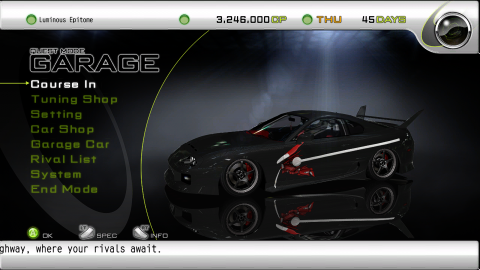
As packages go it’s an interesting one. Fundamentally, the gameplay loop hasn’t really moved on much since the original Dreamcast game: you cruise around the roads, race people, rinse and repeat. The game does have an overarching story (based around your exploits helping to reddem and rehabilitate a mythical racer called King Speed), but looked at as a title with adventurey-RPG pretensions, the game probably doesn’t have as gripping a story as you’d want or as many enough new gameplay features specifically targeted at the action side of things
Mind you, as interesting as the RPG aspects are, it’s probably best to look at Import Tuner Challenge as a racing game above everything else, and if looked at purely as a racing game the level of progression is more or less what we’d expect. There might be less cars overall, but there’s a higher general level of detail in the handling model and more individualized handling for each vehicle over previous titles. Tokyo also looks and feels more realistic than ever. For someone looking for an HD update to the Tokyo Xtreme Racer series in 2006 (like me), Import Tuner Challenge did everything you wanted it to and more.
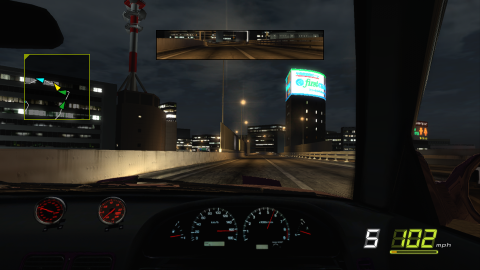
In fact, from a modern perspective maybe it does too much. There are definitely flaws to the modern eye – the interiors look distinctly low res and (like a lot of racing games from this era) the music has been mixed incredibly quietly – but it still looks really good. Though at the time the relatively simple, clean approach many Japanese developers took to their interpretation of high-definition graphics was criticised when compared to the art direction taken by many Western titles, it’s difficult to argue that games like Import Tuner Challenge haven’t aged better. Chuck in some extra anti-aliasing in a modern emulator and you have a game that still looks very, very good – even when compared with the new Tokyo Xtreme Racer that recently released into early access on Steam. I’m definitely not one to question Genki’s ability to add genius nips and ticks to their formula (in the 2025 edition it’s tire wear and the ability to bully civilian mini vans), but I think Genki are probably quite lucky Import Tuner Challenge is stuck in moribund hardware and not actively supported by a modern modding community. If you’re interested in the new game but waiting for it to come to consoles, the 2006 entry is definitely worth a look.

